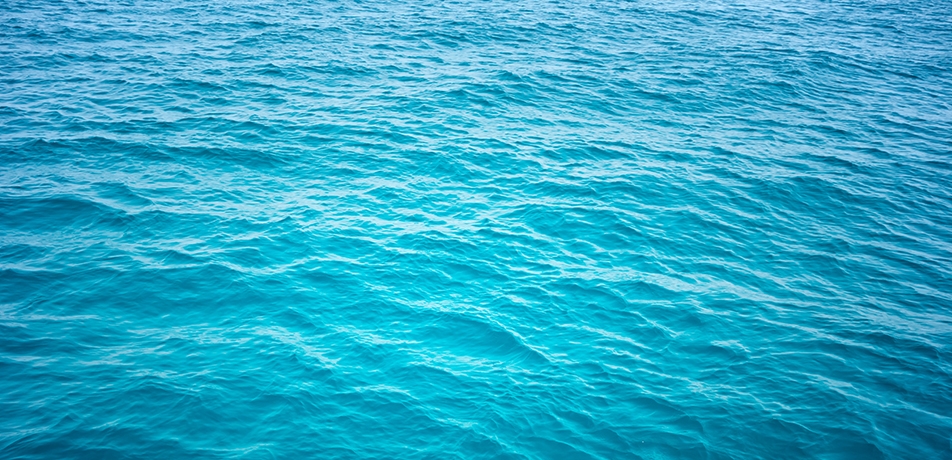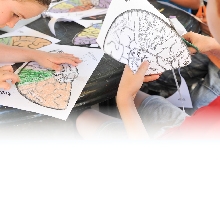The wonders of water
Weizmann Institute research is having a ripple effect
Features

In 1972, an astronaut aboard the Apollo 17 captured “the blue marble”—a photograph that, for the first time, revealed the entire Earth as an isolated ecosystem, floating in space. Named for the ocean expanses that dominate its composition, the blue marble photo became an icon, used by environmentalists to urge people to protect and preserve the water resources upon which life depends.
Today, investigators at the Weizmann Institute are developing new approaches for protecting our beloved blue marble. Many of these scientific strategies stem from one surprising fact: the unique chemistry of H2O—water—can serve as the key to its own salvation.
Clean catalysts, clean energy
As the global population expands, so do human needs—for food, energy, and the materials of modern life. Fulfilling these needs requires industrial chemistry, the processes by which raw materials are transformed into products that can be bought and sold. At a time when pollution was believed to be an unavoidable side-effect of this process, Prof. David Milstein, an Israel Prize laureate and a former head of the Department of Organic Chemistry, devised a way to synthesize industrially important chemicals while using little energy, and produce zero waste.
In research cited by Science magazine as one of the 10 major scientific breakthroughs of 2007, Prof. Milstein discovered that metallo-organic catalysts can drive cost-effective and environmentally friendly synthesis of some of the most fundamental chemical bonds. And he’s made major strides since then.
Peptide bonds are a building block of every protein and are part of many drugs. They are also found in polyamides, the macromolecules that, linked together, form materials ranging from natural silk to synthesized nylon. “Synthesizing peptide bonds typically generates pollution,” says Prof. Milstein, “but our studies demonstrated a clean reaction that produces only a single, harmless by-product: hydrogen gas.”
This discovery led to a breakthrough in the field of green energy.
Hydrogen is the cleanest fuel on the planet, and for years, scientists around the world have been looking for ways to liberate this fuel from water, by using concentrated solar light to break water down into its component parts: hydrogen and oxygen. Prof. Milstein discovered a new water-splitting method that uses both light and a novel, metalbased catalyst.
“Direct use of hydrogen gas as a fuel source is problematic, because of its low energy density and because hydrogen gas is highly flammable and may explode in air,” Prof. Milstein explains. “Our catalysts made it possible to safely load and unload hydrogen from organic liquids on demand, under mild conditions, without the need to store the fuel in gas form.”
And according to Prof. Milstein, the catalytic system may someday help us give up gasoline —for good.
Current approaches involve keeping hydrogen gas under high pressure, or at the ultra-cold temperatures needed to maintain hydrogen in liquid form, both of which require a large energy outlay. Prof. Milstein’s system uses a stable, organic liquid that is inexpensive to produce and which could be used to release chemically bound hydrogen directly, from inside a car’s fuel tank. Then—because the catalytic reaction is reversible—the same liquid could be reconstituted in an external process, thereby replenishing its hydrogen load and enabling repeat use. This makes Prof. Milstein’s approach a sustainable solution for automotive transportation, one of the planet’s biggest sources of pollution.
The technology, called Liquid Organic Hydrogen Carrier, or LOHC, could potentially jumpstart the vehicles of tomorrow. “Our catalysts provide a safe way to chemically store and control the release of hydrogen, which is highly flammable and potentially explosive in its raw form,” Prof. Milstein says. “Such an approach could help realize the potential of the so-called ‘hydrogen economy’, in which plentiful, non-polluting hydrogen would provide all of our energy needs, while producing only one by-product: water.” Efforts towards further technological development of this system are ongoing.
Energy from water
Meanwhile, in another Weizmann lab, scientists have significantly improved the efficiency with which we can split water, and liberate hydrogen for use as fuel. That discovery came from the lab of Prof. Ron Naaman of the Department of Chemical and Biological Physics, who put a new twist on a well-known electrochemical technique.
While scientists have long sought to produce hydrogen from water using solar cells, technical problems have limited the efficiency of the reaction. Together with Prof. Bert Meijer of Holland’s Eindhoven University of Technology, Prof. Naaman recently demonstrated how, by controlling electron spin—the characteristic that makes electrons behave like tiny bar magnets with a north and south magnetic pole—it is possible to suppress generation of a corrosive by-product, thereby increasing the amount of electric current such cells can produce. They reported this achievement in the Journal of the American Chemical Society.
“One of the main obstacles to separating hydrogen is that conventional water-splitting methods result in the production of hydrogen peroxide—a competing process that corrodes some of the cell’s electrodes, making hydrogen production less efficient,” Prof. Naaman explains. “In our work, we investigated how these competing chemical reactions are affected by spin.”
The researchers noted that hydrogen peroxide, by its basic chemical nature, requires two electrons with opposite spins, while atoms of oxygen, in contrast, have spins that are parallel. They hypothesized that if they could align the spins of electrons involved in these oxygen-based chemical reactions, hydrogen peroxide formation would not occur.
The secret to success was paint: The researchers covered one of the photoelectrochemical cell electrodes with organic paint based on supramolecular structures that are chiral (containing molecules that are mirror images of each other). These unique structures enabled the scientists to inject only electrons with their spins aligned in a certain direction into the chemical reaction. This work was based on previous findings from Prof. Naaman’s lab, demonstrating that the transmission of electrons through chiral molecules is selective, depending on the electrons’ spins.
“The effect on water splitting exceeded our expectations, in that the formation of hydrogen peroxide was almost entirely suppressed,” says Prof. Naaman. “Hydrogen could be a game-changer, providing an abundant energy source with negligible environmental impact. We’re now very busy optimizing the process.”
The “aqua material” advantage
Separation technology is at the heart of water purification, along with sewage treatment and a host of industrial processes. A new membrane developed by Prof. Boris Rybtchinski of the Department of Organic Chemistry is tough enough to meet such challenges. And surprisingly, a major component of this material is…water.
His lab has created artificial molecules that take advantage of water’s unique chemical properties, and which assemble into new types of hydrogels—water-rich materials that form flexible, three-dimensional networks of great strength and toughness. “With at least 60% of the human body made up of water,” Prof. Rybtchinski says, “you could say that we are all walking hydrogels.”
Prof. Rybtchinski’s molecular assemblies have become the basis of a filtration membrane capable of separating particles based on size, from one to several nanometers. It is environmentally friendly because it is fully recyclable—it can be dissolved and then rapidly reassembled. This offers a practical solution for membrane “fouling”, a common problem in separation technology.”
And there’s more. Membranes recently produced by the Rybtchinski lab contain a second self-assembled layer, which broadens the range of applications in which they can be used. These new membranes can sustain high pressures and are capable of purifying water from poisonous heavy metals, as well as from organic molecules produced by the pharmaceutical industry. Such drug-based compounds are increasingly finding their way into the marine environment, affecting human health and upsetting the biological balance of ecosystems worldwide.
“Our materials are strong enough to meet the most challenging requirements,” Prof. Rybtchinski says. “They also reduce pollution because, unlike the plastics used in traditional separation techniques, our membranes are 70% water and can be easily recycled. This is good for the planet, and also points the way toward using water-based ‘aqua plastics’ in future, environmentally friendly applications.”
Clean water everywhere
While nearly 70 percent of the world is covered by water, only 2.5 percent of it is safe to drink, and fully 97 percent of this potable water is found underground. Protecting underground water sources from contamination is essential because polluted water isn’t just dirty—it’s deadly.
Prof. Brian Berkowitz of the Department of Earth and Planetary Sciences is a hydrologist whose quantitative models of underground water flow— which inform the work of engineers and regulatory agencies all over the world—make it possible to predict how contaminants will spread. And when contamination occurs, protecting drinking water is a race against time.
The standard limit for organic contaminants or heavy metals in drinking water is four parts per billion. “This means you’re already in the danger zone when the amount of polluting material in water rises to the equivalent to eight grains of sand in a ton of peanut butter,” Prof. Berkowitz says. “Such a tiny amount of contamination—which can flow in unexpected directions—represents a massive problem.”
Prof. Berkowitz’s model of groundwater dynamics grew out of a combination of experimental observation and statistics. In the lab, he performed ‘packing’ experiments to track the movement of dye through constructed cross-sections of various ground materials. A series of wells dug in the open field provided a similar platform, showing how injected “contaminants”—environmentally benign tracers—made their way from one well to the other. The experimental results formed the basis of a probability-based model of underground contaminant flow, which was made available to the wider hydrology community.
Prof. Berkowitz is also interested in groundwater chemistry. Close examination of chemical reactions—such as the underground CO2 that breaks down rock, resulting in carbolic acid—can make cleanup efforts more effective, by taking into account dynamic changes in a water system’s vulnerability.
Prof. Berkowitz recently developed a new and proactive approach to groundwater pollution: a nanotechnology-based system that degrades and “defangs” contamination before it spreads.
“Scientists have long known that adding certain chemicals to water can cause the breakdown of contaminants, but this breakdown is incomplete and slow,” he says. “We fabricated metal-based catalysts that achieved 100% degradation of water contaminants. Dangerous pollutants were completely transformed into harmless oxygen and carbon. The patented technology, now being developed for commercial licensing, has the potential to revolutionize pollution treatment methodologies in industrial settings.
And as technology advances, so does the need for new water clean-up strategies.
“We’re now moving to an era in which materials necessary for the construction of high-tech devices like cellphones, computers, and advanced lighting systems are being dumped into landfills with no understanding how these elements affect the groundwater,” he says. “The trick is not to try to solve a global problem, but to do the basic research that will help us understand the messes that we’ve made. If we’re lucky, the data we come up with will lead us to a way to clean it all up.”
Prof. David Milstein is supported by the Bernice Peter Cohn Catalysis Research fund, and he is the incumbent of the Israel Matz Professorial Chair of Organic Chemistry.
Prof. Ron Naaman is supported by the Nancy and Stephan Grand Research Center for Sensors and Security, which he headed from 2010-2015, as well as the Rothschild Caesarea Foundation. He is the incumbent of the Aryeh and Mintzi Katzman Professional Chair.
Prof. Boris Rybtchinski is supported by the Solo Dwek and Maurizio Dwek Research School of Chemical Science, which he heads; the Leona M. and Harry B. Helmsley Charitable Trust; and Dana and Yossie Hollander, from Israel.
Prof. Brian Berkowitz is supported by the Calgary chapter of Weizmann Canada, the Crystal Family Foundation, the P. & A.Guggenheim-Ascarelli Foundation, Stan and Ellen Magidson, Rochelle Rubinstein, and Ms. Darlene Switzer-Foster and Mr. Bill Foster. Prof. Berkowitz is the incumbent of the Sam Zuckerberg Professorial Chair in Hydrology.








